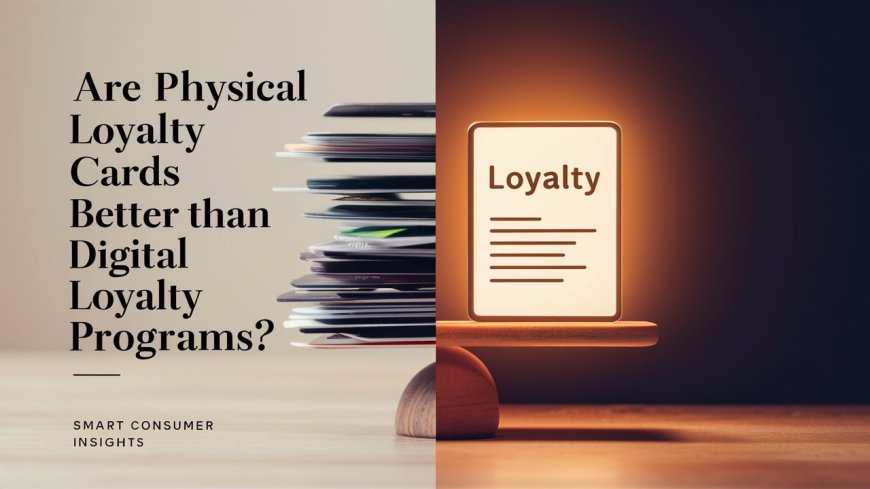Are Physical Loyalty Cards Better Than Digital Loyalty Programs?
Explore the pros and cons of physical loyalty cards versus digital programs. Find out which option works best for your business.

Loyalty programs are everywhere these days. From coffee shops to grocery stores, everyone wants to reward you for sticking with them. But how those rewards are delivered has changed a lot. Some stores still hand out physical loyalty cards, while others have gone fully digital, letting you access everything through your phone.
It’s easy to see why digital programs are gaining popularity. They’re convenient, quick, and packed with features like personalized deals and real-time updates. But does that mean physical loyalty rewards cards are outdated? Not necessarily. For some, the feel of a card in their hand or the simplicity of a quick scan is hard to beat.
So, which is better? Is the reliability of a physical loyalty card worth more than the convenience of a digital program? Or does it depend on how you like to shop?
Why Physical Loyalty Cards Still Hold Their Ground
Physical rewards cards have stood the test of time, proving that sometimes, simple solutions work best. While apps and digital tools dominate, physical cards continue to offer unique benefits.
1. Tangibility That Sparks a Connection
There’s something comforting about holding a loyalty rewards card in your hand. It’s not just a tool; it feels like proof of your loyalty and membership. Every time you open your wallet and see it, the card becomes a silent reminder of your preferred store or service.
-
Physical cards create a tangible connection, offering a sense of value that digital apps sometimes fail to replicate.
-
For businesses, the presence of their branded card in your wallet acts as free advertising. The card goes wherever you go, constantly reinforcing the relationship.
2. Simplicity and Reliability
Physical loyalty cards are straightforward and dependable. They don’t rely on a phone’s battery, an internet connection, or app updates to function.
-
At the checkout counter, there’s no need to open apps or navigate a menu. You simply swipe or scan the card.
-
For older customers or those uncomfortable with technology, physical cards eliminate the stress of using unfamiliar systems.
-
Unlike apps that occasionally crash or fail to load, physical cards never leave you stranded in line.
3. Privacy Without Trade-Offs
Physical loyalty cards respect your privacy. Unlike digital platforms, they don’t demand access to your location, shopping habits, or personal data.
-
Customers worried about privacy breaches or targeted ads find physical cards to be a safer choice.
-
These cards don’t track you or bombard you with notifications, offering a less intrusive experience.
The Appeal of Digital Loyalty Programs
While physical cards are dependable, digital loyalty programs bring a level of convenience and functionality that paper and plastic can’t compete with.
1. All-in-One Convenience
Digital reward loyalty cards store everything you need on your phone. No more rifling through a wallet full of cards or worrying about leaving one behind.
-
Most apps let you save multiple cards, ensuring everything is in one place. You can manage points, check balances, and redeem rewards effortlessly.
-
Forgetting a loyalty card at home is no longer an issue. With a digital wallet, you’re always prepared.
2. Real-Time Updates and Offers
Digital loyalty programs keep you connected to the latest deals and rewards. Through push notifications, emails, or SMS alerts, you’ll always know when a sale or exclusive offer is happening.
-
Some programs offer instant point updates after a purchase, showing exactly how close you are to your next reward.
-
Personalized offers are tailored to your shopping habits, making deals feel more relevant.
3. Gamification and Engagement
Digital platforms often incorporate gamification, making loyalty programs more engaging. You might earn badges, unlock milestones, or participate in challenges to earn extra points.
-
These interactive elements create excitement and keep customers engaged with the brand.
-
Gamification often translates into more frequent use, as users feel motivated to reach the next reward level.
Comparing the Two: Which One Wins?
While physical loyalty rewards cards and digital programs both aim to reward loyalty, their strengths and weaknesses differ. The table below highlights key differences to help you decide:
|
Feature |
Physical Loyalty Cards |
Digital Loyalty Programs |
|
Ease of Use |
Simple swipe or scan, no tech skills needed |
May require app navigation or updates |
|
Accessibility |
Always works, no battery or internet is needed |
Requires a smartphone and a stable connection |
|
Data Privacy |
Doesn’t track or share data |
May collect data for marketing purposes |
|
Portability |
Adds bulk to the wallet |
All cards in one device |
|
Rewards and Updates |
Limited to in-store interactions |
Real-time updates, personalized deals |
|
Engagement |
Basic, with no interactive features |
Gamified elements keep users engaged |
Pain Points of Loyalty Rewards Cards in Today’s World
While both options have their merits, they’re not without challenges. Physical and digital loyalty rewards cards need to address several pain points to remain effective.
1. Too Many Programs, Too Little Time
Shoppers are overwhelmed with loyalty programs. Everyone seems to have one, from grocery stores to gas stations. This abundance often leaves people juggling multiple cards and apps.
-
Physical loyalty cards can clutter wallets, while digital apps can be forgotten if not regularly used.
-
Customers want simple programs that stand out rather than blend into the noise.
2. Lack of Standardization
Not all loyalty programs are created equal. Some require long waiting periods to redeem points, while others have overly complicated rules.
-
Physical cards might only be usable in-store, limiting their utility.
-
Digital programs often have terms buried in the fine print, leaving users frustrated when rewards don’t match expectations.
Verdict: What Works Best for You?
The choice between physical loyalty rewards cards and digital programs depends on your preferences and shopping habits.
-
Physical loyalty cards are ideal for customers who value simplicity, privacy, and reliability. They’re low-maintenance and don’t demand constant attention.
-
Digital loyalty programs, on the other hand, shine when it comes to convenience, engagement, and real-time updates. They cater to tech-savvy shoppers who enjoy interactive experiences.
Ultimately, the best loyalty reward card system is one that aligns with your lifestyle, offering value without unnecessary complications. Whether you choose the feel of plastic in your hand or the efficiency of an app, the key is to find a program that truly rewards your loyalty.
Want to Upgrade Your Loyalty Program? DuraCard offers durable, customizable loyalty cards designed to leave a lasting impression on your customers. Let’s create a loyalty solution that stands out – and stands the test of time as well.
FAQs
Can I use both physical and digital loyalty programs for the same store?
Yes, many stores offer both options. You might have a physical loyalty rewards card for in-store purchases and access a digital version through their app for online shopping. Some programs even let you link the two, so your rewards are synchronized.
Are physical loyalty cards being phased out completely?
Not entirely. While many brands are prioritizing digital programs, physical loyalty cards are still popular, especially among customers who prefer simplicity or don’t use smartphones. Some businesses continue to offer them as an alternative.
Which option is more secure: physical loyalty cards or digital programs?
Both have their risks. Physical cards can be lost or stolen, while digital programs may collect and store your personal data, raising privacy concerns. Digital programs often use encryption and account protection to reduce risks, but it’s important to use secure passwords and monitor your accounts.
What happens if I lose my physical loyalty card or forget my account login for a digital program?
For physical cards, you’ll usually need to contact the store’s customer service to get a replacement. For digital programs, you can reset your account login via email or app support. Some stores may let you link your new card or account to your previous rewards.
Are digital loyalty programs free to use?
Yes, most digital loyalty programs are free to join. However, some may offer premium features or memberships for an added cost, like earning rewards faster or accessing exclusive deals. Always read the terms before signing up.
What's Your Reaction?

























